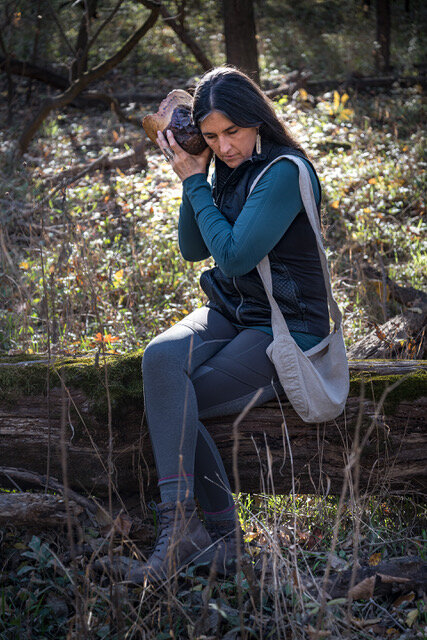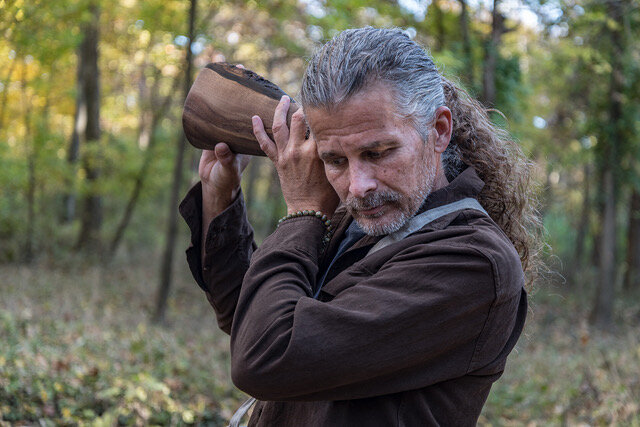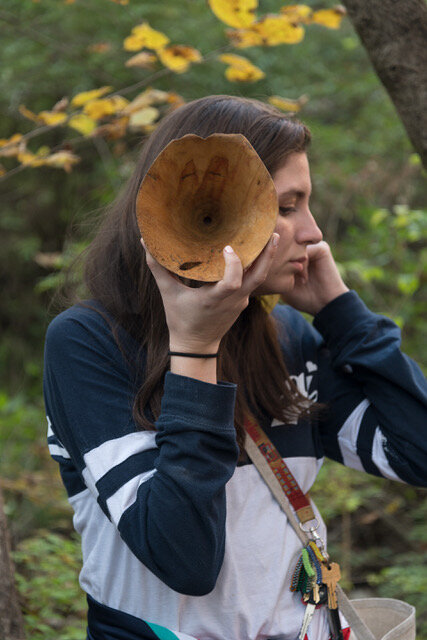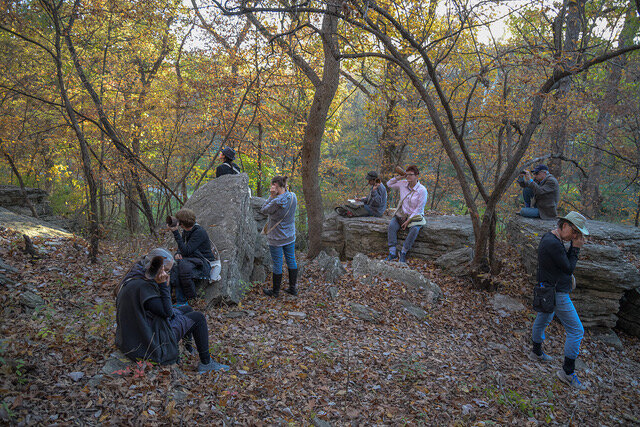Quote from Karen McCoy regarding my experience as an artist participating in the Open Spaces exhibition by leading Sound and Sight Walks.
2018
It was a unique and special privilege to have participated in Open Spaces. I learned so much from my audiences, leading them on Sound and Sight Walks on the Fox Hollow Trail behind the Lakeside Nature Center in Swope Park. We explored our city in a new way. Imagining an experience, sculpting or composing it, in such a way that viewers must walk to discover it is, in itself, an act overlaid with many intentions. Since the "situational sculpture" consists of a dispersed experience, it also calls upon the person experiencing it to remember and mentally assemble all the parts in order to experience the whole. For the Sound and Sight Walks each participant carried, in a custom-made linen sac, a hand carved wooden listening/sighting horn for their own use. We periodically exchanged these these horns that I had carved from burls using regional tree species. (Burls are bulbous growths caused by damage to tree, this damage creates irregular grain patterns beloved by many wood carvers.) Each horn may be considered a small sculpture prepared for opening a new way of experiencing aural and visual phenomena. After all, our ears and eyes provide a conduit from the outer world into the inner realm of each individual.
By placing an ear to the small end of a wooden trumpet one may listen more closely to sounds produced by birds, frogs, insects and other animals, human-made sounds, the wind as it rustles leaves and branches, and, especially alongside Fox Hollow Creek, to water as it flows over rock ledges, and through pebbles or gravel. By using the large or small circular aperture at either end to sight and frame an image the conical horns may also be used to isolate visual phenomena. In this way the play of moving light and shadow may become a miniature "film" or the brilliance of green mosses, the patterns of lichens spread on a boulder may become miniature abstract pictures. The emphasis is on increasing sensory perception through concentrating, focusing and isolating particular sounds and sights. The use of these small handmade objects on walks places emphasis on the contemplation of a place and its special and spatial qualities.
In the future, perhaps noise pollution from technological devices, personal and otherwise, and from our ever-expanding cities will be so increased that sound quality might form the basis for retreats from the urban. The concept of the park as a quiet zone is not unthinkable. Walking with a small wooden horn in hand creates a situation in which viewer/participants may take a sort of journey to discover that which is available all the time, to anyone, but seldom noticed. It takes time, patience and concentration to hear and see in a new way. As each Sound and Sight horn makes its way into a variety of soundscapes; or is used as a visual sighting instrument, it becomes part of a larger sculptural experience..
Each Saturday was different for me as an artist because, not only was the weather and atmosphere distinct, but each group of Kansas Citians, or visitors from farther afield, brought their own personalities and created a new ethos or blend. Some groups had children who brought their own sense of curiosity with them. Once an elderly woman who wasn’t sure she would last the whole walk (she did!), sometimes musicians came, or artists, there were folks of all ages, races and ethnicities walking, discovering together and sharing experiences. One special Saturday we had a collaboration with two percussionists who presented a short concert at Lakeside Nature Center, and then, later, as we approached Fox Hollow Creek on our Sound and Sight Walk, we heard unusual sounds emanating from the Creek itself. The percussionists met us there and played with instruments they had brought but ended by asking us all to take a rock in each hand and create rhythms.
Utilized as listening devices, the horns provide a way of "cupping our ears to the earth". Concentrating on small aural or visual fragments in the environment can alter our perception of place. Walking with a focus on sound, listening and close scrutiny of the immediate environment invites a slower pace and an attendant increase in sensory perception. When we engage in this kind of heightened perception we find that it may filter into our daily lives. Listening as part of a geographical experience creates a process of assembling sound into an aural picture of the landscape; likewise with viewing visual fragments. These may contribute to a new and deeper experience and vision of our local landscape.















